Hey, everyone. Welcome to my new article. Today we are going to discuss how insulin receptors work and how these receptors perform the intracellular signaling. In simple words, what kind of pathways are activated by the activations of insulin receptors? But before we go into that, we need to have some basic idea of insulin.
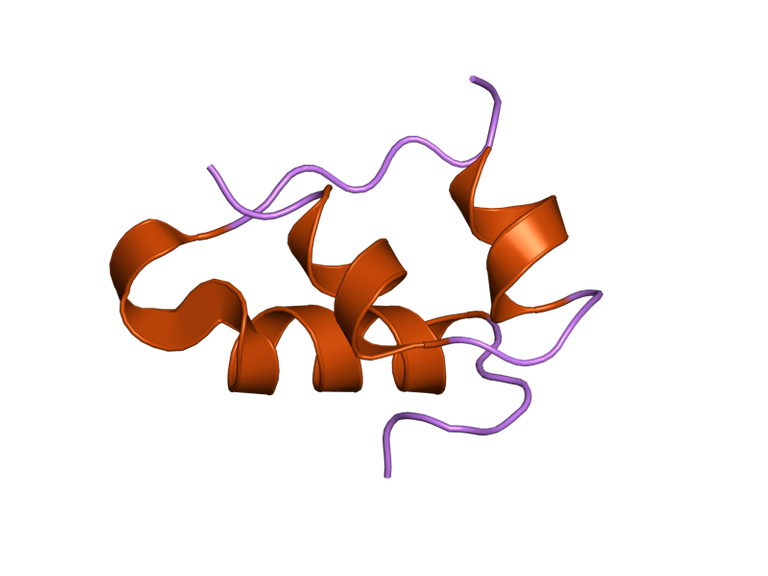
Basic Idea of Insulin
If we define insulin in a single sentence, we can say "Insulin is a very strong anabolic hormone". It is to be noted that its an anabolic hormone. Anabolism means the synthesis of complex and larger molecules from the relatively smaller ones with the purpose of the storage of energy. So, what does insulin basically do In our body? , here's a basic idea.
- It enhances the anabolic mechanism in our body and suppresses the catabolic mechanism.
- Therefore, insulin leads to synthetic functions.
- Synthetic functions mean, it helps in the synthesis of glycogen, proteins, lipids.
- Also, insulin helps in cell growth. and maturation.
How is insulin secreted?
Whenever we consume food, we intake a lot of nutrients. For example, you have consumed a carbohydrate-rich meal. Carbohydrate is broken down to smaller molecules by your Digestive system. That smaller molecule is called Glucose. similarly, amino acids for protein and fatty acids for lipids. These small molecules can be seen as fuels for our bodies and need to be utilized or stored in a proper way.
Through the bloodstream glucose travels to Pancreas. The pancreas has two functions, exocrine and endocrine. for this topic we are going to talk about endocrine functions. Endocrine functions are done by the islets of Langerhans. Basically, they are the collection of special endocrine cells. The main cells found are alpha cells, beta cells, and delta cells.
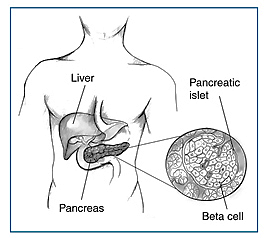
when glucose enters islets of Langerhans, Beta cells of the pancreas are triggered. we can call them glucose sensors. Glucose enters the beta cells. This leads to the formation of ATP or energy inside the beta cells. which in turn opens the calcium channels and calcium influxes into the cell. This calcium influx leads to the secretion of insulin from the beta cells.
Now, we have the basic idea of insulin and its secretion. We will have a look at how insulin acts on different cells, namely, muscles cells, liver cells and adipose tissue(fat cells)
Insulin Receptor and Its signaling pathway
As I have mentioned all the functions of insulin above. Insulin needs to perform all these things but there is a problem. Insulin is a relatively large molecule consisting of 51 amino acids. Therefore it's a large peptide and large molecules cannot enter into the cells. SO, a special type of insulin receptors is found on the cell surface that helps in the insulin signaling pathway.
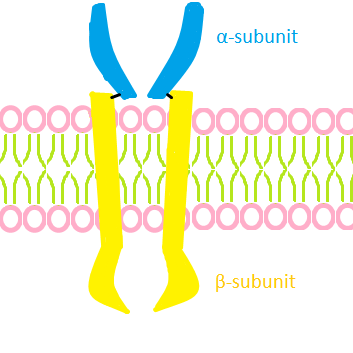 Fig-II: Insulin receptor(Credits, Wikimedia, Under reuse license)
Fig-II: Insulin receptor(Credits, Wikimedia, Under reuse license)
The insulin receptor is a special type of receptor containing two alpha chains and two beta chains. these chains are held together by disulfide bonds. the alpha chains are totally extra-cellular while beta chains are partly extracellular, partly transcellular, and partly intracellular.
Insulin attaches itself to this receptor at the alpha subunit which starts a cascade of pathways. These pathways are responsible for glucose entering the cells and many other things like protein metabolism, lipids metabolism, growth, etc.
Insulin Signaling pathways.
When insulin attaches itself to the insulin receptors it starts a series of pathways. Firstly there is a change in the configuration of the receptor. Change in the configuration activates the receptor. Here the change in configuration means, there is a transformation of alpha subunits which leads to activation of beta cells tyrosinase activity. This leads to cross phosphorization of beta subunits. Now, the receptor is completely activated.
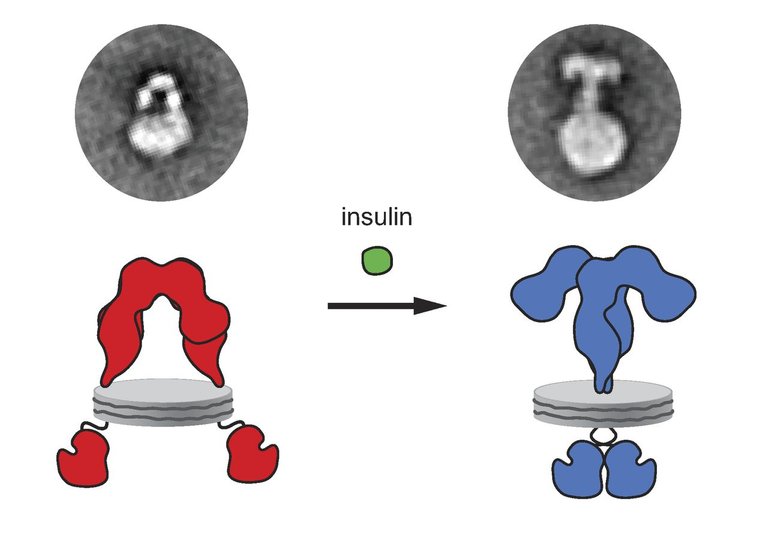
Fig 3: Change in configuration (Credits, Wikimedia, Under reuse license)
You can see how the change in configurations occurs when insulin attaches itself to the receptor.
The activated beta subunits then attach itself to a new peptide. This peptide is known as Insulin receptor substrate(IRS). There are various types of IRS proteins found in different cells.
When this IRS protein is activated, it will get other proteins like PI3K to bind to it. It binds to IRS by SH2 domain. The main function of PI3K is to activate another type of protein namely PIP2 to PIP3 in the plasma membrane. This leads to an increased concentration of PIP3. The increased concentration of PIP3 will recruit new types of protein PDK1 and AKT protein towards the plasma membrane.
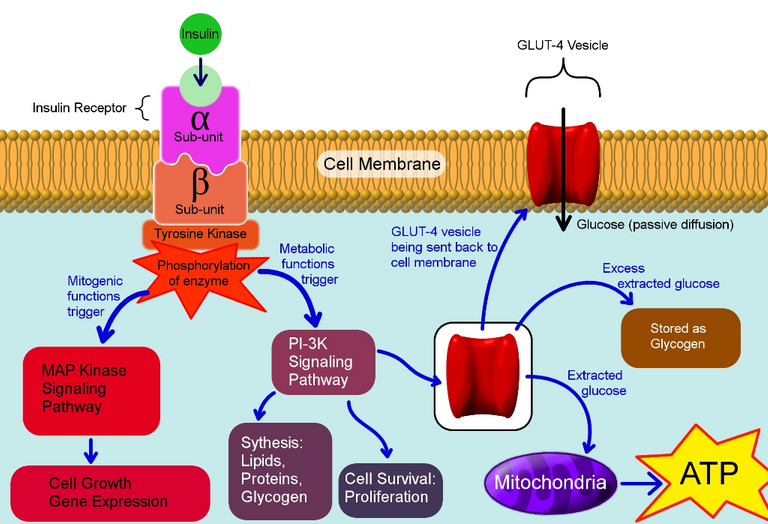
Fig 4: Insulin Signalling pathways (Credits, Wikipedia, Under re-use license)
Cells have a reservoir of vesicles that already contains glucose transporters. Those glucose transporters are embedded in the vesicles itself. Note that those vesicles are intracellular. Glucose transporters are insulin-dependent and known as GLUT-4. for GlUT-4 to work, it needs to be embedded in the plasma membrane, so that glucose can enter the cells. In a cell, that is not stimulated by insulin, there is a protein AS160 continuously inhibiting this GLUT-4 receptor to embed in the membrane. However, when the cell is stimulated by insulin, AS160 protein is deactivated by AKT protein. This then allows the GLUT-4 translocation to occur in the plasma membrane of the cell. Once Glut-4 is in the membrane, glucose can easily enter the cells. Similarly, the cell also becomes more permeable to proteins and lipids.
What happens after glucose enters into the cells?
Once, the glucose enters into the cells, it is needed to be stored. That means the anabolic pathway needs to be increased and the catabolic pathway needs to be decreased inside the cell.
This can be well understood by the table given below.
| carbohydrate | Protein | Lipids | |
|---|---|---|---|
| Anabolic | ↑Glycogenesis | ↑Protein Synthesis | ↑Lipogenesis |
| Catabolic | ↓Glycogenolysis ↓Gluconeogenesis | ↓Protein Synthesis | ↓Lipolysis |
Glycogenesis means the formation of glycogen molecules from glucose. Glycogenolysis means a breakdown of glycogen to release glucose. Gluconeogenesis means the formation of glucose from nonglucose sources. Similarly, there is more protein and lipid synthesis and less breakdown.
How insulin regulates gene expression?
The processes up to insulin attachment to the insulin receptor and activation of IRS protein are the same. This pathway is going on side by side to the above-described pathway. When the IRS molecule is activated it's another SH2 domain grabs a new type of protein.
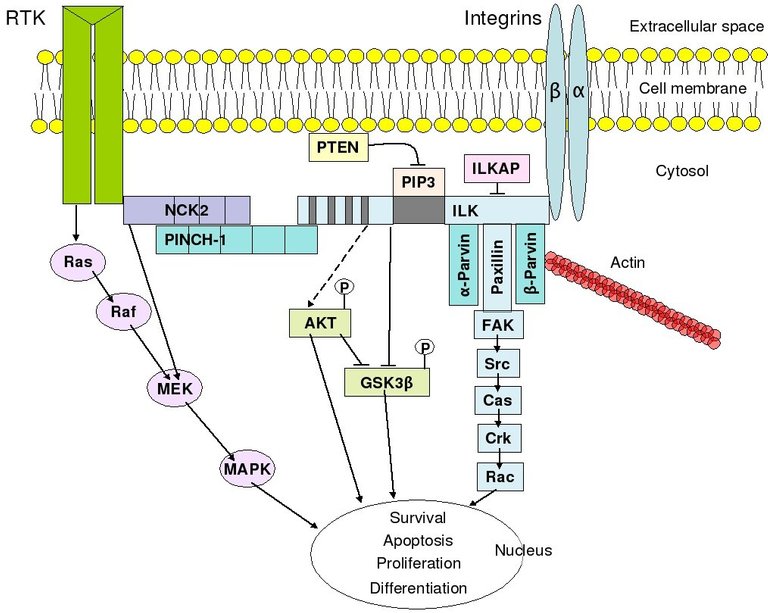
Fig 5: Gene expression pathway (Credits, Wikipedia, Under reuse license)
This protein is known as Grb2. This activated Grb2 protein then recruits another protein called SOS(son of sevenless). Again, activated SOS protein replaces GDP molecule on RAS protein to GTP. In turn, this activates RAS protein. A series of kinase cascade starts from this point. Firstly, Raf protein, Mek protein, and finally ERk proteins are activated (also known as MAPK). This activated Erk protein then enters inside the nucleus through special pores. It acts on a transcription factor known as MYC molecule to initiate the transcription. Transcription simply means making RNA from DNA, which will be used for protein synthesis.
You stayed until the end. Hope you enjoyed the article.
*All images used are copyright free and are provided with appropriate credits*
References:
[1]
https://en.wikipedia.org/wiki/Insulin
[2]
https://en.wikipedia.org/wiki/Insulin_signal_transduction_pathway
[3]
https://www.sinobiological.com/research/signal-transduction/rtk
[4]
https://www.endocrineweb.com/conditions/type-1-diabetes/what-insulin
its a very complex pathway. explained so simply.
@tipu curate
Upvoted 👌 (Mana: 0/2)
That's a good article. Thanks for sharing.
!discovery 35
This post was shared and voted inside the discord by the curators team of discovery-it
Join our community! hive-193212
Discovery-it is also a Witness, vote for us here
Congratulations @idoctor! You have completed the following achievement on the Hive blockchain and have been rewarded with new badge(s) :
You can view your badges on your board And compare to others on the Ranking
If you no longer want to receive notifications, reply to this comment with the word
STOPTo support your work, I also upvoted your post!
Support the HiveBuzz project. Vote for our proposal!
Great and easy to digest for those who are not familiar with this type of topic!
Thanks for your contribution to the STEMsocial community. Feel free to join us on discord to get to know the rest of us!
Please consider supporting our funding proposal, approving our witness (@stem.witness) or delegating to the @stemsocial account (for some ROI).
Please consider using the STEMsocial app app and including @stemsocial as a beneficiary to get a stronger support.